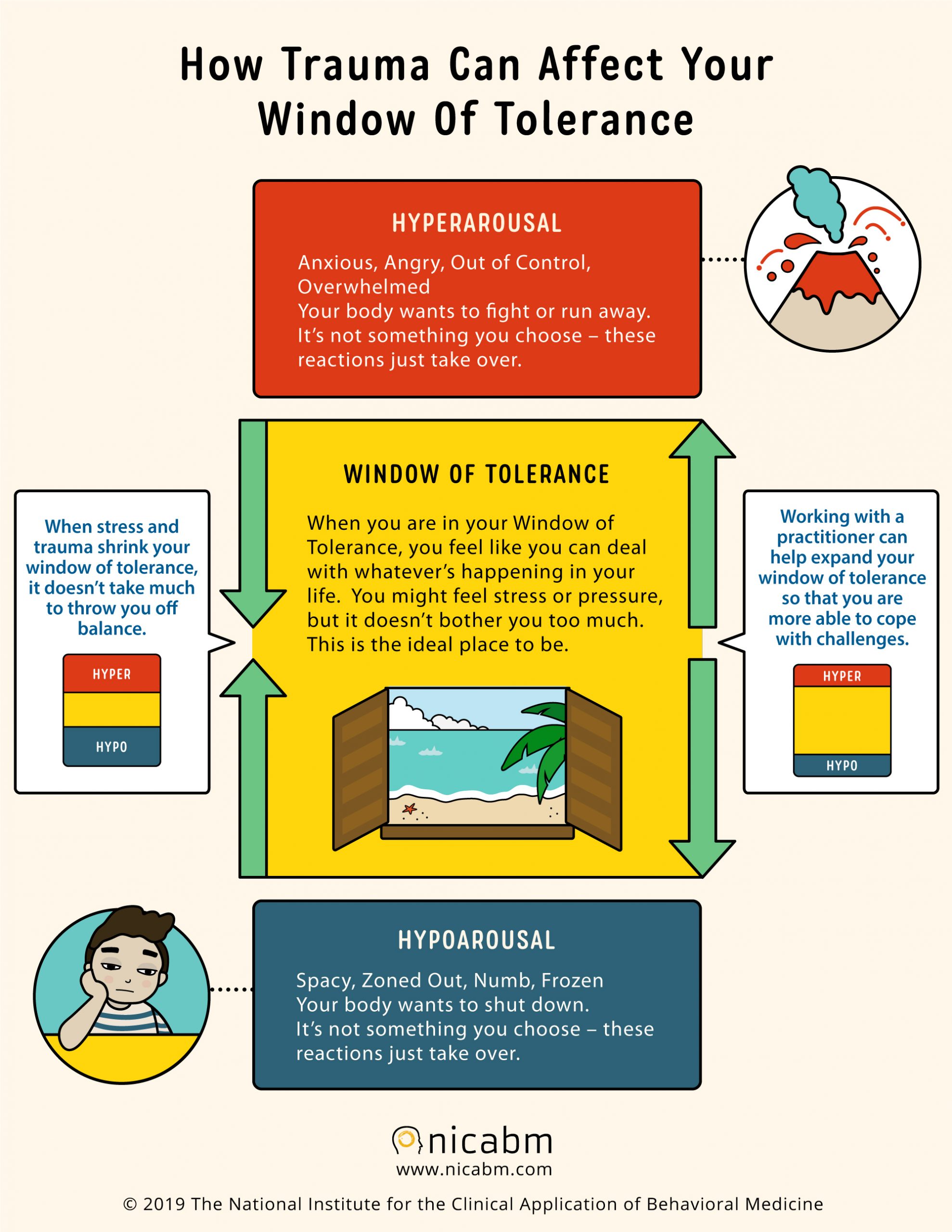
I’ve been mulling over how to effectively write this post for some time. If I am absolutely honest, my brain fog issues and feelings of imposter syndrome have been making my ability to write rather challenging as of late. You see, I may be the creator of a shop for folks with mental health complaints, but I am also someone who struggles with mental health. I have Complex PTSD. But today’s post is not about Complex PTSD, per se. It is however, related, in the sense that I am able to use my personal experience with C-PTSD and the stress intolerance, anxiety and depression that it triggers, to hopefully introduce you all to the concept of the window of tolerance, and how using our 5 senses can actually soothe the frustrating and unsettling symptoms of anxiety, stress and depression. After all, the main core of my business is about using the senses to soothe your body’s fight-flight-freeze reaction. So, if you’re interested (which you likely are otherwise you wouldn’t be visiting Kalmeleon), let’s begin!
The Window of Tolerance is a theory that was originally developed by Dr. Dan Siegel for his book in the late 90’s “The Developing Mind”. The concept refers to the zone of arousal in which we are able to optimally function in our everyday lives. When we are operating within this zone, or window, it generally means that our brain is functioning in a manner that facilitates healthy managing, regulating and coping with our emotions. However, operating out of our window of tolerance, we are more likely to experience (short-term or long-term depending on the situation) mental health complaints such as anxiety and depression.
Professionals often mention the Window of Tolerance when discussing people who have experienced trauma, because trauma survivors often have greater difficulty with regulating their emotions than those who have not experienced trauma. Their functional window of tolerance is also effectively more narrow due to the fact that their bodies often stay more or less continually activated in the fight-flight-freeze response.
A trauma survivor’s difficulties with regulating their emotions and arousal states means that it can be challenging for them to stay grounded in the present, which also unfortunately means that they may respond to even minor stressors, in an extreme way. They can more readily be pushed into a state of hyper- or hypo-arousal.
But you do not necessarily need to have experienced trauma to find yourself pushed outside of your window of tolerance. People who generally function in the optimal window, can also experience hyper– or hypo-arousal states when they experience chronic or severe stress or otherwise negative events. The only difference is that a person who regularly functions in the optimal zone will often have an easier time getting back into their healthy window once their stressor or negative situation has been resolved, because their window is not as narrow and their ability to use positive coping strategies is more effective.
Anyone who frequently operates outside of their window of tolerance is more likely to experience mental health complaints like anxiety and depression. Which makes the window of tolerance concept an incredibly useful tool when dealing with dysregulation.
So we’ve mentioned hyper- and hypo- arousal, but what are they exactly?
Hyper- and hypo- arousal are both states of arousal that we humans have inherited from our primitive ancestors. They are often also called the fight-flight-freeze response.
Fight, flight and freeze are our body’s three most basic stress responses. When our amygdala (the part of our brain that perceives fear) senses threat, it responds by sending signals to the hypothalamus. The hypothalamus is the part of our brain which is responsible for stimulating the autonomic nervous system (ANS), which itself consists of the sympathetic and parasympathetic nervous systems. It is these two systems that are responsible for the fight-flight-freeze responses.
Sympathetic nervous system = fight-or-flight
Parasympathetic nervous system = freeze
Once your ANS has been stimulated, your body then releases the hormones adrenaline and cortisol (the stress hormone). It is the release of these hormones in our bodies that cause our physiological reactions like faster or lower heart rate (usually faster= fight or flight, lower = freeze), faster or more shallow breathing (again usually faster = fight or flight, shallow/slower = freeze), increased blood flow to the core of your body and major muscles, resulting in cold hands and feet, etc. etc.
The ANS is therefore responsible for the following hyper- and hypo- arousal symptoms as shown on this infographic from the National Institute for the Clinical Application of Behavioral Medicine (NICABM) for the window of tolerance :

Hyperarousal = Fight-or-flight, or the sympathetic nervous system:
In both of these instances you may also turn to substance abuse or other addictions, with the hope that they may help soothe your symptoms.
Hypoarousal = Freeze, or the parasympathetic nervous system:
So how do the 5 senses play a role in helping us soothe our fight-flight-freeze response?
When we’re in states of both hyper- and hypo- arousal, our sense organs are affected by the hormones as mentioned above. Here are 5 examples:
There are many useful resources that discuss how to help yourself get back into the optimal window of tolerance (see my first reference below), but I’m going to leave some of that information up to those resources. In this post, I want to focus mainly on how you can use the 5 senses, as well as other positive coping skills to soothe your fight-flight-freeze response, thereby getting you back in the preferred zone of your window of tolerance.
Positive coping skills focus mainly on self-soothing, healthy distraction, mindfulness, emotional awareness, and doing an opposite action that would be more consistent with a positive emotion instead of indulging your first impulse. See Opposite Action example below:
Sensory coping tools are often used for self-soothing as they are meant to either be activating, or in the case of sensory overload, de-activating, for your senses. They are also great tools to aid in healthy distraction, as well as to help you to exercise mindfulness.
Coping tools and strategies are great for both kids and adults. It doesn’t matter if you have anxiety, depression, stress, trauma, or if you’re neurodivergent. The aim with coping tools is always the same: to help you calm down and come back to your optimal arousal state.
So without further ado, I’d now like to share a list I’ve compiled with great ideas for useful coping tools:
A great way to do this is to create a small photo album.
I have a file on my computer that is filled with my favourite internet memes for this very reason.
I enjoy watching old videos of Bob Ross or funny cat videos.
Items with your favorite scent or a scent that you find pleasant/soothing. However, as with all things, moderation is best. Sometimes too much of a good thing can cause sensory overload:
Tip: My daughter and I both use Warmies stuffed animals. They are great as a soft fuzzy cuddly toy, they often have a light lavender-scent, they can be used warm or cold, and they have a gentle weighted effect.
I recently had a very daunting dental surgery which could have triggered my medical ptsd, but the dentist was kind enough to put on the Best of David Bowie for me. This was done to help me focus my attention on something that could keep me calm.
I actually follow a cat on instagram because I adore the sound of her crunching her treats. Plus, she’s adorable.
Great on so many levels. Not only is it self-soothing, it’s also a healthy distraction that helps you to become better emotionally aware and mindful.
When I am feeling anxious, sometimes I can stop a panic attack before it starts by playing Animal Crossing.
This one is hit or miss with me. I do trauma-informed yoga at home, but there are times when even this can be too much.
This list is by no means exhaustive. Some senses and some activities work better for some people than for others. And that’s okay. Sometimes it takes a lot of trial and error to truly figure out which positive coping tools are right for you. But when you do find out what works to bring you back to your optimal window of tolerance, those tools can be great additions to your mental health complaints coping arsenal.
Wishing you a good mental health day.

Kristi Janssen is the creator of Kalmeleon, but above all a mother, a thriving complex trauma survivor, and a breaker of toxic cycles.
Wil je op de hoogte blijven van ons laatste nieuws en producten? Of ben je op zoek naar zowel leuke als nuttige ideeën voor het verminderen van je angst- en stressklachten? Volg ons op Instagram of Facebook en help ons kennis over angst- en stressmanagement te verspreiden!
| Cookie | Duur | Beschrijving |
|---|---|---|
| cookielawinfo-checkbox-analytics | 11 months | This cookie is set by GDPR Cookie Consent plugin. The cookie is used to store the user consent for the cookies in the category "Analytics". |
| cookielawinfo-checkbox-functional | 11 months | The cookie is set by GDPR cookie consent to record the user consent for the cookies in the category "Functional". |
| cookielawinfo-checkbox-necessary | 11 months | This cookie is set by GDPR Cookie Consent plugin. The cookies is used to store the user consent for the cookies in the category "Necessary". |
| cookielawinfo-checkbox-others | 11 months | This cookie is set by GDPR Cookie Consent plugin. The cookie is used to store the user consent for the cookies in the category "Other. |
| cookielawinfo-checkbox-performance | 11 months | This cookie is set by GDPR Cookie Consent plugin. The cookie is used to store the user consent for the cookies in the category "Performance". |
| viewed_cookie_policy | 11 months | The cookie is set by the GDPR Cookie Consent plugin and is used to store whether or not user has consented to the use of cookies. It does not store any personal data. |